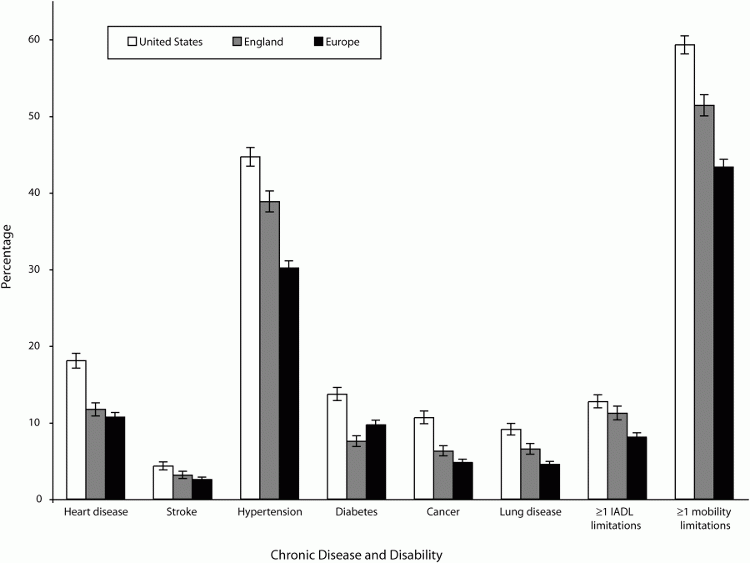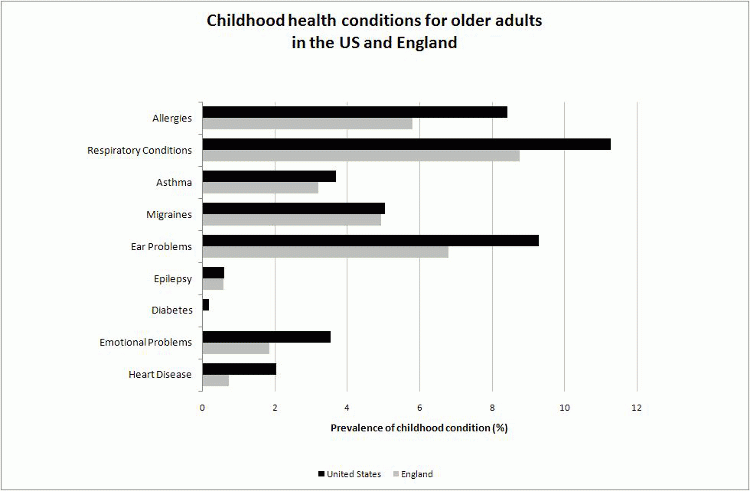Considerable empirical research is now underway looking at how people’s health, social status, and economic fortunes develop over the course of their lives. As examples, early work suggested that health outcomes at adult ages may be traced in part to health and other conditions during childhood (e.g. Barker 1997, Case et al. 2002).
Following these studies, Case et al. (2005) investigated the persistent impacts of childhood health on adult health, employment, and socioeconomic status using a 1958 British birth cohort who were tracked into their adult years. They found that people who experienced poorer health outcomes either in terms of low birth weight or presence of chronic conditions when they were children
- had worse health as adults,
- passed fewer O-level exams,
- worked less during their adult years, and
- had lower occupational status at age 42 even after controlling for standard measures of parental background such as education and income.
As part of our ongoing investigation into the causes and consequences of differences in health at older ages between the US and England (Banks et al. 2011), it was therefore natural for us to ask whether differences in early life history play a role.
More specifically, can the poor health of older cohorts of Americans relative to their English counterparts be explained at least in part by differences in early life health or socioeconomic circumstances?
Our research is based on two cohort surveys:
- the English Longitudinal Study of Aging (ELSA), and
- the American Health and Retirement Survey (HRS)
These contain well-measured longitudinal data on health, work, and economic circumstance for samples drawn from the population aged 50 and older in England and the US respectively.
Americans are sicker in old age
These data clearly show that, across a wide range of diseases, older Americans are significantly sicker than their English counterparts. Biomarker-based measures of illness demonstrate the same patterns, and subsequent research adding European data to the picture confirmed the US disadvantage in late-life health.
Figure 1. US-England-European health differences amongst adults aged 50-70
Note: Figure reports prevalence rates (%), adjusted for age, sex, education, smoking, drinking, BMI, state/country. See Avendano et al. (2009)
In 2006, modules containing questionnaires that fill in missing events from respondents' life histories prior to their first ELSA or HRS interview were added to these studies. With regard to childhood health, in addition to a subjective question rating their childhood health before age 16 on the standard five-point scale from excellent to poor, respondents in both surveys were asked about the occurrence and date of onset of a set of common childhood illnesses. These data show that prevalence of childhood disease is also higher in the US than in England, especially if relative risk is the metric for comparison (Figure 2).1 Supporting evidence for an American excess of childhood disease compared to the English also comes from Martinson et al. (2011) who demonstrate using biomarker data from NHANES and the Health Survey for England that there is also an American excess of childhood disease for current cohorts of children.
Figure 2. Childhood health conditions for older adults in England and the US
Note: The figure gives the fraction of individuals born before 1957 and surviving to 2007 who reported that they had each childhood condition before they were aged 16.
We divided adult health outcomes into three groups according to self-reported doctor-diagnosed diseases. Major illness was defined to include cancer, lung disease, stroke, angina, heart attack, and heart failure. Minor illness includes hypertension, diabetes, and arthritis. “Barker” illnesses include those related to heart disease and diabetes (angina, heart attack, heart failure, hypertension, and diabetes) – the diseases that are at the core of the Barker hypothesis linking early to later life health.
We then estimated a set of models that attempted to isolate the salient country differences in adult disease prevalence and how they related to childhood health. These models all contain age and its square, a male gender dummy, and a country dummy (US = 1). The male and age variables were all interacted with the US indicator variable, but these interactions were not statistically significant, i.e. there was no evidence of anything other than a uniformly higher US disease excess.
We expanded our models by including measures of childhood socioeconomic status (based on occupation of fathers), parental health (based on mortality status and age of death of mother and father), and the list of childhood diseases.
Our results for the estimated American excess are listed in the table below. In the baseline model, we find an American excess for all three categories of adult disease that is not diminished by including our controls for childhood socioeconomic status. However, adding childhood diseases does help account for a significant part of the country differences.
For example, for major diseases we have an age-adjusted raw difference of 7.2 percentage points of excess disease in the US. The adjusted difference is 4.1 percentage points (and not statistically different from zero), so that 43% of the US excess major disease is explained by childhood diseases compared to the base case model. Using the same metric, 23% of the excess in minor disease and 28% of the US excess in the Barker diseases are explained by childhood circumstances.
Table 1. Summary of estimated US excess adult illness
|
Model
|
Major
|
Minor
|
Barker
|
|
Baseline (adjusted for age and sex only)
|
0.072**
|
0.145**
|
0.111**
|
|
+ childhood socioeconomic status and parental health
|
0.069*
|
0.120**
|
0.098**
|
|
+ Childhood diseases
|
0.041
|
0.110**
|
0.080*
|
|
+ Childhood diseases but without US interaction with disease
|
0.082*
|
0.113*
|
0.113**
|
**Statistically significant at 1% level. *Statistically significant at 5% level.
One final model included these childhood diseases but removed the interactions of the diseases with the US country dummy. On comparison of these results with those discussed above, it is apparent that the main contribution to the reduction in both the size and statistical significance of the US country effect arises from the inclusion of the interaction terms – i.e. whilst there is some role for the greater prevalence of childhood conditions in the US, it is the differential impacts of these childhood conditions on later-life health outcomes in the US that has the main effect on changing the coefficient on the US dummy variable. Whilst these interaction terms are just another form of “country effect”, this does suggest that investigation of the mechanisms by which early-life health is transmitted to late-life disease outcomes in the two countries would be a promising avenue for future research.
Conclusions
The origins of poorer adult health among older Americans compared to the English traces back right to their childhood years. Conditions in the US appear to make its residents of all ages sicker than the English. This highlights a caution that age-specific answers to the question of why Americans are sicker may not serve as a useful guide to uncovering the more fundamental causes of this important question. Our research shows that the primary sources of the US excess in disease are not unique to mid-adulthood or old age but are more common throughout the age distribution of the two populations.
Finally, it is worth noting that, since we are dealing with the onset of disease rather than the treatment of disease, the medical system and availability of health insurance are not likely to be the primary actors in this puzzle, especially when we consider that we use a non-Hispanic white sample such that 95% of our US sample have access to health insurance.
References
Avendano, M, M Glymour, J Banks, and JMackenbach (2009), “Health Disadvantage in US Adults Aged 50-74: Are Poor Europeans Healthier than Americans?”, American Journal of Public Health, 99:540-548,
Banks, James, Michael Marmot, Zoe Oldfield, and James P Smith (2006), “Disease and Disadvantage in the US and in England”, Journal of the American Medical Association, 295(17):2037-2045.
Banks, James, Zoe Oldfield, and James P Smith (2011), “The Role of Childhood Health on Later Life Outcomes in England and America”, NBER Working Paper 17096.
Barker, David (1997), “Maternal Nutrition, Fetal Nutrition and Diseases in Later Life”, Nutrition, 13(9):807-813
Case, Anne., Angela Fertig, and Christina Paxson (2005), “The Lasting Impact of Childhood Health and Circumstance”, Journal of Health Economics,24(2):365-389.
Case, Anne, Darren Lubotsky, and Christina Paxson (2002), “Economic Status and Health in Childhood: The Origins of the Gradient”, American Economic Review,92(5):1308-34.
Goodman, Alissa, Robert Joyce, and James P Smith (2011), “The Long Shadow Cast by Physical and Mental Problems on Adult Life”, Proceedings of National Academy of Sciences (PNAS), 1108(15):6032-6037.
Martinson, Melissa, Julien Teitler, and Nancy Reichman (2011), “Health Across the Life Span in the US and England”, American Journal of Epidemiology, 173(8):858-865.
Smith, James P (2009a),“Re-constructing Childhood Health Histories”, Demography, 46(2):387-403.
Smith, James P (2009b),“The Impact of Childhood Health on Adult Labour Market Outcomes”, Review of Economics and Statistics,91(3):478-489.
Smith, James P, and Gillian C Smith (2010), “Long-Term Economic Costs of Psychological Problems during Childhood”, Social Science and Medicine, 71(1):110-115.
1 A legitimate question is whether these recall histories are to be believed. There are three potential sources of bias—mortality, illness detection, and recall. The first two are not unique to retrospective data and would exist if the information had been collected in real time. But in fact, mortality rates before age 50 are actually higher in the US than England so if sicker children died at earlier ages this would imply we may be understating the US excess in children’s poor health. While memory biases certainly may play a role, salient events may suffer less from this type of memory decay and memory of childhood happenings appears to be superior than for other times of life - Smith (2009) shows that American data from these recall histories on childhood health show similar patterns to those collected from contemporaneous historical sources.






